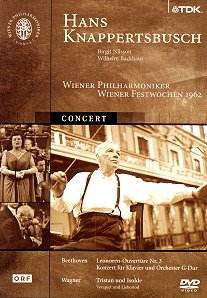Between them, the BBC,
EMI, and TDK are making a wealth of
fascinating visual material available
to us which allows those who are interested,
to understand better, how the great
conductors achieved the results they
did. Long may this continue, as it is
a marvellous way to be entertained by
the really great musicians of the past,
and in some cases even the present.
This DVD, if issued
in today’s environment, would be classed
as a "celebrity event" and
indeed that is just what it is, except
that these terms were not around when
the recordings were made. The undoubted
star of the concert is the conductor
Hans Knappertsbusch. I will not be tempted
into the pretentious epithet "Kna"
as some reviewers use, so here Knappertsbusch
will be Knappertsbusch.
Knappertsbusch had
the reputation of being very light on
rehearsals, indeed when first encountering
the Vienna Philharmonic in 1929, he
rehearsed only the first half of the
concert. About the second half, Beethoven’s
Eroica symphony he told the orchestra
"You know the work, I know the
score." A contemporary violinist
in the orchestra remembers "He
radiated such confidence on the evening
of the concert that a rehearsal had
indeed not been necessary." We
are not told in the notes whether the
present concert was rehearsed beforehand,
but there is no cause for worry – the
results are excellent.
Tradition would have
us believe that Knappertsbusch’s interpretations
were highly controversial, which was
part of his legendary reputation, but
here, all is largely quite normal given
the historical basis of the concert.
His beat is the clearest it could be,
and the orchestra, is intent on watching
it intently, something which is often
missing from current day concerts. Maybe
he was tempered by his soloists, particularly
the 78 year old Wilhelm Backhaus who
had said when interviewed "Believe
me, not a day of my life has gone by
without my trying to play the introductory
bars of this concerto. That is so terribly
difficult and I have never really been
satisfied."
Based upon current
evidence, this goes very well, as far
as the rest of the concerto is concerned,
apart from a few finger problems which
will not bother all but the most fussy
listeners / watchers of this DVD. The
picture is in grainy black and white,
and the sound whilst being in mono,
is quite clear without being in the
least bit "hi-fi". There is
a little distortion but this is in no
way serious, and the overall experience
is very entertaining as well as being
a fascinating historical document. I
never realised that history could be
so interesting.
The concert starts
with a funereal paced account of the
Leonore No. 3 Overture, which soon picks
up speed and ends with a large rush
of adrenaline to produce a very good
atmosphere for the concerto. The film
during the interval between the two
works concentrates on the latecomers
finding their seats, which I find adds
a little humour to the proceedings.
This livens up the monochrome film,
and I am sure that this part was severely
edited, as no stage hands could re-arrange
the orchestra and bring on the piano
in such a relatively short space of
time.
Backhaus sits at the
piano like a god playing like a dream
with absolutely no show of emotion other
than what is emanating from his fingers.
There are some rhythmic distortions
but it is the skill of the conductor
accompanying his soloist perfectly around
each such minor change of tempo within
the bar lines which makes this performance
so interesting.
After the concerto,
the orchestra is joined by the then
young Birgit Nilsson singing the glorious
Liebestod from Wagner’s Tristan und
Isolde. Caught in her absolute prime,
this most illuminating of Wagnerian
sopranos gives a superb rendition of
this most moving Wagner "bleeding
chunk," and it rounds off a most
satisfying programme.
John Phillips
